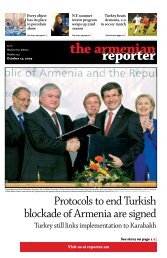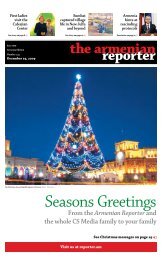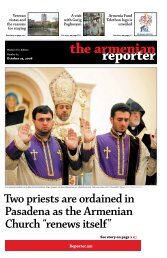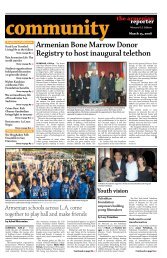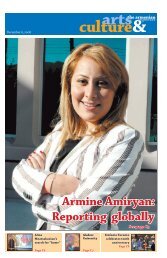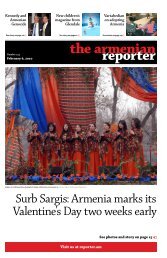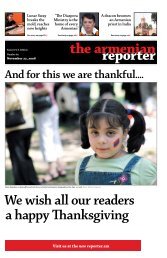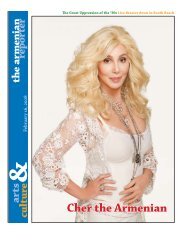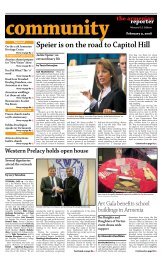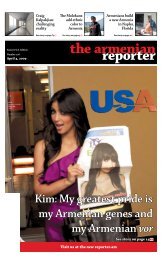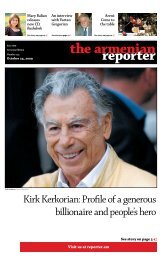The <strong>Armenian</strong> <strong>Reporter</strong> | November 22, 2008Nationalby Emil SanamyanObama, Biden intelephone talks with<strong>for</strong>eign leadersPresident-elect Barack Obamaand Vice President–elect JoeBiden called a number of “worldleaders and expressed thanks andappreciation <strong>for</strong> their congratulationson the election.”The presidential transition <strong>we</strong>bsite www.change.gov reports thaton November 6, Mr. Obama tookcalls from leaders of close U.S. alliesAustralia, Great Britain, Canada,France, Germany, Israel, Japan,Mexico, and South Korea. On November7 he spoke with leaders ofItaly, Spain, Poland, Egypt, SaudiArabia, and Pakistan, and on November8 with those of Russia andChina.The president-elect phoned PresidentsAbdullah Gül of Turkey andMikheil Saakashvili of Georgia,as <strong>we</strong>ll as the Philippines presidenton November 17; the presidents ofColombia, Nigeria, Senegal, andSouth Africa, and United Nationssecretary general on November 18;Washington briefingObama on phone wth <strong>for</strong>eign leaderson Nov. 6 in Chicago. Getty images.and the presidents of Argentina,Chile, Kazakhstan, and Palestine,and the Irish Prime Minister, onNovember 19.No details of conversations <strong>we</strong>rereported by the president-elect, butMr. Saakashvili’s office reportedthat “the U.S. President-elect expressedhis unconditional supportto the territorial integrity of Georgiaand focused on the importanceof continuation of the ongoingre<strong>for</strong>ms in Georgia [and] U.S. supportin <strong>this</strong> regard.”<strong>And</strong> according to Mr. Gul’s office,Mr. Obama “emphasized theimportance of the special relationsbet<strong>we</strong>en the two allies, Turkey andU.S.” and backed Turkey’s fightagainst Kurdish rebels.Other calls to <strong>for</strong>eign leaders<strong>we</strong>re made by Sen. Biden. On November10 he telephoned the Israeli<strong>for</strong>eign minister, Tzipi Livni, whois likely to be the next prime minister,Defense Minister Ehud Barak,and opposition leader Binyamin(Bibi) Netanyahu; Britain’s PrimeMinister Gordon Brown, as <strong>we</strong>llas the presidents of Poland andAfghanistan and, on November 11,the king of Jordan.<strong>And</strong> on November 17, Mr. Bidencalled the European Union’s JavierSolana, as <strong>we</strong>ll as the presidents ofColombia and Georgia, the primeminister of Spain, and the <strong>for</strong>eignminister of Greece.Turkish leader deridesBush, lobbies ObamaTurkey’s Prime Minister RecepTayyib Erdoğan used an invitationfrom President GeorgeW. Bush to an economic summitin Washington to lecture President-electBarack Obama and tolambast the Bush administration’spolicies as “disastrous.”Although Mr. Obama himself declinedto take part in the summit,he asked <strong>for</strong>mer Secretary of StateMadeleine Albright, <strong>for</strong>mer Rep.Jim Leach (R.-Iowa), and PhilipGordon of the Brookings Institutionto meet with <strong>for</strong>eign leaderson his behalf.According to Turkish media, inmeetings with Mr. Obama’s representativesand in speeches atBrookings on November 14 and aday earlier at the Columbia University,Mr. Erdoğan touted Turkey’simportance and warned PresidentelectObama about Turkey’s “sensitivities”such as its insistence ondenial of the <strong>Armenian</strong> Genocideand opposition to a de facto Kurdishstate in Iraq.In his presidential campaign, Mr.Obama repeatedly pledged to dropthe Bush administration’s policyand stop deferring to the Turkishlobby when it came to U.S. policyon the <strong>Armenian</strong> Genocide.Separately, Mr. Obama pledgedto pull U.S. troops out of Iraq withinsixteen months.Mr. Erdoğan criticized the withdrawalplan as “premature” and therecognition pledge as “immature.”At Brookings, the Turkish leaderclaimed that “U.S. support is essential<strong>for</strong> maintaining the dialogue”bet<strong>we</strong>en Turkey and Armenia,implying that Ankara would stopseeking normal relations with Yerevanif President Obama, in Mr.Erdoğan’s words at Columbia, acquiescedto <strong>Armenian</strong>-Americans’“cheap political lobbying” and speakclearly on the genocide in OttomanTurkey.Also at Columbia, Mr. Erdoğanspoke of his desire to follow therecent Russian example and hosta meeting bet<strong>we</strong>en the <strong>Armenian</strong>and Azerbaijani presidents.<strong>And</strong> in Washington, Mr. Erdoğanrepeated his offer to mediate bet<strong>we</strong>enthe United States and Iran,while suggesting that Tehran cannotbe <strong>for</strong>ced to drop its nuclearprogram while other countries(presumably Israel, India, andPakistan in addition to the UnitedStates, Russia, France, Britain, andChina) retain nuclear <strong>we</strong>apons.Pres. Sahakian at a Armenia Fundproject inauguration in Dec. 2007.Karabakh presidentbegins U.S. visitPresident Bako Sahakian of theNagorno Karabakh Republic (NKR)began a 10-day working visit to theUnited States on November 18. Mr.Sahakian’s delegation includes NKRFinance Minister Spartak Tevosianand other officials.The trip is dedicated to the annualThanksgiving Day telethon insupport of Karabakh and Armeniaorganized by the Armenia Fund inLos Angeles and includes stops inBoston and New York <strong>for</strong> meetingswith <strong>Armenian</strong>-American communityleaders.Since its creation in 1992, thefund has supported key transportationinfrastructure in Karabakhwith about $185 million spent onprojects throughout Armenia.Georgia cedes its natural gas network to AzerbaijanNerses Yeritsian.U.S.-Armenia TaskForce meets inWashingtonEconomic Development MinisterNerses Yeritsian led an <strong>Armenian</strong>government delegation to Washington<strong>for</strong> talks with U.S. officialsfrom November 19 to 21.The visit was within the regularU.S.-Armenia Task Force (USATF)mechanism and included visits withofficial counterparts at the Departmentsof State and Commerce, theOffice of the U.S. Trade Representative,and the Millennium ChallengeCorporation. The USATF’s Americanco-chair is currently DanielRosenblum, the State Departmentassistance to Eurasia coordinator.USATF was previously co-chairedby Armenia’s Finance and EconomyMinisters Levon Barkhudarian(1999–2000) and VardanKhachatrian (2000–2008), andU.S. State Department Coordinators<strong>for</strong> U.S. assistance to EurasiaBill Taylor (2000–2003) and TomAdams (2004–2008).Set up in 2000, USATF is an intergovernmentalcommittee thatmeets twice a year to discuss U.S.assistance <strong>for</strong> Armenia’s re<strong>for</strong>msand bilateral economic ties.Ho<strong>we</strong>ver, the volume of U.S. assistanceto Armenia has declinedfrom an average of $75 million ayear in 2004–2006 to about $50million in 2007. Bilateral trade remainedsteady at an average of $125million a year in 2004–2007, withU.S. exports to Armenia accounting<strong>for</strong> most of the turnover. fNews Analysis by EmilSanamyanWASHINGTON – Georgia agreedto hand over the ownership of itsnatural gas network, which includesthe transit gas pipeline fromRussia to Armenia, to the Azerbaijanigovernment, news agenciesreported.Under the November 14 deal,announced by Georgian leaderMikheil Saakashvili the next day,Azerbaijan would satisfy the bulkof Georgia’s natural gas needs in2009–13 at below-market prices.The deal was finalized duringan energy summit in Baku thatbrought together a number of centraland eastern European headsand senior officials of states interestedin Caspian energy.Also at the summit, Kazakhstanagreed to expand its oil shipmentsvia Azerbaijan, Georgia, and Turkeythrough the Baku-Tbilisi-Ceyhanpipeline built with U.S. support.“Property <strong>for</strong> debt”Georgia’s deal with Azerbaijan issimilar to Armenia’s deal with Russia,exchanging <strong>for</strong>mal ownershipof the gas network – that could potentiallyserve as political leverage– <strong>for</strong> a temporary reprieve in prices.Until <strong>this</strong> year, like Armenia,Georgia bought most of its naturalgas from Russia. Moscow reportedlycame close to buying theGeorgian gas network, but the offerwas declined by Tbilisi on the U.S.government’s insistence, whichwas concerned with integrity ofnon-Russian gas supplies.Although the Georgian-Russianborder is closed and official relations<strong>are</strong> suspended, Russia continuesto supply Georgia, and by extensionArmenia, with natural gas.The biggest gas consumers in Georgia– the Tbilisi electricity networkand a chemical plant – <strong>are</strong> ownedby Russian companies.While Russian-Georgian talkson South Ossetia and Abkhazi<strong>are</strong>sume in Geneva <strong>this</strong> <strong>we</strong>ek, nonormalization in relations is anticipatedany time soon.Speaking at the Council on ForeignRelations in Washington on November15, President Dmitry Medvedevsaid that Russia was “ready tobuild relations with Georgia.”“But not with the current [Saakashvili]regime,” Mr. Medvedevsaid. “That is a red line, which <strong>we</strong>cannot cross.”Armenia impactAzerbaijan has now promised tocover more than 60 percent ofGeorgia’s overall gas needs – estimatedat 1.8 billion cubic metersof gas a year – at below-marketprices. The rest of the supplies toGeorgia would still need to comeat market prices from Azerbaijan,Russia, or Iran.Iran-Armenia gas pipe at Saralenj. Photo: Photolure.Armenia imported more than2 billion cubic meters of gas fromRussia last year. In addition to thenow Azerbaijani-owned Georgiantransit pipeline, Armenia can nowpotentially import natural gasfrom Iran – an important safeguardshould new problems arisein supplies via Georgia. The Iranoption also becomes more attractiveas Russia will begin to raiseprices <strong>for</strong> its supplies startingnext year.Consequences <strong>for</strong> Armenia ofthe Georgia deal may become app<strong>are</strong>ntsoon. Azerbaijan and Turkeyhad previously used a promiseof lo<strong>we</strong>r gas prices to Georgia asleverage against Armenia in the<strong>for</strong>m of Georgian support <strong>for</strong> theKars-Akhalkalaki rail bypass andother projects.The Russian-Georgian war alreadydisrupted air and other trafficbet<strong>we</strong>en Russia and Armenia. Medi<strong>are</strong>ports suggested that Georgiawas trying to prevent Russian militarycargo, including those resupplyingits military base in Gyumri,from reaching Armenia.Considering the continued importanceof Georgia transit to Armenia,it is not surprising that bothPresident Serge Sargsian and DefenseMinister Seyran Ohanianhave visited Georgia since the Augustwar, and Prime Minister TigranSarkisian is expected to gosoon.f
The <strong>Armenian</strong> <strong>Reporter</strong> | November 22, 2008InternationalLooking <strong>for</strong> <strong>Armenian</strong>s in Turkish state museumsHacking historyby Ara Sarafian in AnkaraANKARA, Turkey – <strong>Armenian</strong>s havebecome a common topic of discussionin Turkey <strong>for</strong> some years nowand <strong>this</strong> trend has picked up sincePrime Minister Recep TayyibErdoğan came to office in March2003. In <strong>this</strong> new climate of moreopenness, liberal intellectuals haveled a discussion of the <strong>Armenian</strong>Taboo of Turkey.Their discussions have led to anew aw<strong>are</strong>ness of <strong>Armenian</strong>s anda gradual reinvention of Turkey’s<strong>Armenian</strong> heritage, which was destroyedin large measure in 1915and its aftermath. The new positivediscussions have touched on suchissues as <strong>Armenian</strong> history, art,architecture, music, and cuisine indifferent publications, exhibitions,and public discussions.Fethiye Çetin’s book Anne Annem(My Grandmother) has beenreprinted in several editions. OsmanKöker’s exhibitions and publicationshave reached thousands.Orhan Pamuk’s comments aboutthe persecution of Kurds and <strong>Armenian</strong>s<strong>are</strong> reported by the worldmedia. All <strong>this</strong> suggests some tangiblebreaks with Turkey’s moreominous past.Ho<strong>we</strong>ver, the more sympathetictreatment of <strong>Armenian</strong>s hascontinued to take place alongsidelongstanding conservative, belligerent,and negative attitudestoward <strong>Armenian</strong>s. These circlescontinue to slight, marginalise,and vilify <strong>Armenian</strong>s as a matterof course.Their attitudes, supported bystock arguments, <strong>are</strong> the productof decades of Turkish nationalistindoctrination and its underlyingideology. Even in the last <strong>we</strong>ek <strong>we</strong>have heard Turkey’s Defense MinisterVecdhi Gönül applaud the“departure” of the native <strong>Armenian</strong>and Greek communities of Turkey,and Minister of Justice MehmetAli Sahin defend the utility of theinfamous Article 301. He explicitlydefended the prosecution of TemelDemirer under Article 301 becausethe latter had called Turkey a statethat murdered its own citizens(with reference to <strong>Armenian</strong>s andKurds).Within the academic domain,the Turkish Historical Associationand the Turkish military continueto prep<strong>are</strong> and publish overtlyanti-<strong>Armenian</strong> books and DVDs– invariably denigrating <strong>Armenian</strong>sand denying the <strong>Armenian</strong> Genocideof 1915. Various “think tanks,”such as the Ermeni ArastirmalarMerkezi (<strong>Armenian</strong> Studies Center)in Ankara remain actively anti-<strong>Armenian</strong>. Many small publishinghouses still print the conventionalTurkish nationalist position regarding<strong>Armenian</strong>s.Attempts to reinvent Turkish<strong>Armenian</strong>s in a more positive light<strong>are</strong> still undermined by significantsectors of Turkish society, includinggovernment ministries. Therelative strength of the opposingconservative circles has still notbeen gauged, especially given theirpositions of po<strong>we</strong>r and influencein Turkey. While one cannot expectthe Turkish conservative-nationalistposition to change overnight,one does expect it to takesome note of new discussions andrevelations.Two <strong>we</strong>eks ago I decided to examineseveral museums in Turkey,all but one in historic Western Armenia,with one question in mind:“How <strong>are</strong> Armenia and <strong>Armenian</strong>srepresented in Turkish museumstoday?”Turkish schoolchildren on a day trip to the Museum of Anatolian Civilizations in Ankara. Photos: Ara Sarafian © 2008Gomidas Institute. Used with permission.The Museum of Anatolian Civilizations in Ankara.The museums I picked <strong>we</strong>re theMuseum of Anatolian Civilizations(Ankara), Erzurum ArchaeologicalMuseum, Van ArchaeologicalMuseum, and Kars ArchaeologicalMuseum. All four <strong>are</strong> under thecontrol of the Ministry of Tourismand Culture.Had the new debates on <strong>Armenian</strong>sshaped representations of<strong>Armenian</strong>s in Turkey? How didthese state institutions acknowledgeand contextualize <strong>Armenian</strong>history in their everyday endeavors,and what can <strong>we</strong> say about Turkeyand its <strong>Armenian</strong> heritage basedon these museums.First stop: AnkaraMy first stop was the Museum ofAnatolian Civilizations in Ankara.This museum uses the term Anatoliaas coterminous with the territoryof Turkey-in-Asia. Of course,Turkey is not a single landmass,but <strong>for</strong>med of several distinct geographicalregions, such as the Aegeanlittoral, the Konya plain, thePontic mountains on the Black Sea,the Taurus Mountains of the Mediterranean,the anti-Taurus furthereast, and of course the <strong>Armenian</strong>highlands.This museum is reputed to be oneof the most important museums inTurkey today. It won the EuropeanMuseum of the Year Award in 1997,and many tourists, schoolchildren,and academics visit it every day.The museum exhibition extendsover two floors. It is <strong>we</strong>ll constructedand maintained, with excellentlighting and good human resources.Starting from the prehistoricera, the visitor is led through collectionsof Paleolithic, Neolithic,Chalcolithic, Early Bronze Age, Assyrian,Hittite, Phrygian, Urartianand Lydian, Greek, Roman, Seljuk,and Ottoman artifacts.The displays at the museum includestatues, pottery, je<strong>we</strong>lry, andmetalwork, and various panels discussthe collections in their broaderhistorical contexts, with referencesto other civilizations such as theMedes, Scythians, Egyptians, andPersians.Ho<strong>we</strong>ver, there <strong>are</strong> no artifacts,discussions, or references to <strong>Armenian</strong>sin the museum.The obvious question is, there<strong>for</strong>e,why is there no mention ofArmenia as a geographical entityor <strong>Armenian</strong>s as a culture and civilization?After all, there was theempire of Tigran the Great in thefirst century B.C.E., the <strong>Armenian</strong>Kingdom of Vasbouragan on LakeVan in the 10th–11th centuries, andthe <strong>Armenian</strong> Kingdom of Ciliciain the Middle Ages. Armenia wasa distinct part of the Roman andByzantine Empires, and <strong>Armenian</strong>s<strong>we</strong>re one of the important pillars ofthe Ottoman Empire. <strong>Armenian</strong>splayed a major role in arts, crafts,and trade throughout the ages, andthey developed their own distinctidentity with their own alphabetfrom the 5th century in <strong>this</strong> <strong>are</strong>a.<strong>Armenian</strong> literature, philosophy,art, and architecture <strong>are</strong> worthyof much comment, yet they do notappear in a museum dedicated toAnatolian civilizations.The only reference to <strong>Armenian</strong>sI saw at <strong>this</strong> museum was a multilingualDVD prep<strong>are</strong>d, interestinglyenough, by the Turkish Ministry ofThe Museum of Ethnography in Ankara.Culture and Tourism called The <strong>Armenian</strong>Issue: Allegations and Facts.The other reference was a smallbook on Akdamar (sic, Aghtamar)Island, which made some derisoryremarks about <strong>Armenian</strong>s, but includedmore sensible discussionafterward.By way of explanationAfter my visit to the museum, Iraised what I had seen with twoTurkish colleagues, both membersof the Turkish Historical Society.They proceeded to explain that <strong>Armenian</strong>s<strong>we</strong>re not mentioned in theMuseum of Anatolian Civilizationsbecause they did not constitute astate. Obviously, there have been<strong>Armenian</strong> states in the <strong>are</strong>as underdiscussion. Their explanation alsoseems to suggest that “states” and“civilizations” <strong>are</strong> the same thing.I asked one of them why <strong>Armenian</strong>s<strong>we</strong>re not represented withindiscussions of these states, <strong>for</strong> examplein the case of the OttomanEmpire. After all, the OttomanEmpire was a multicultural entity,probably with more Christiansthan Muslims at its height. <strong>Armenian</strong>s<strong>we</strong>re indistinguishable fromTurks, I was told in response, sothere was no need to say anythingabout <strong>Armenian</strong>s.I do not know if they <strong>we</strong>re embarrassedby my questions and didnot know what to say, or they reallythought their explanation hadmerit. I doubt it was the latter, andI hope they will do something aboutthe issue, if only to save Turkey furtherembarrassment.While I was in Ankara, I also visitedthe Museum of Ethnography.One of the figures in the garden of theMuseum of Anatolian Civilizations.DVD cover.Just as the Museum of AnatolianCivilizations did not mention <strong>Armenian</strong>s,the Museum of Ethnographyalso did not see <strong>Armenian</strong>sas an ethnicity. Indeed, the ethnographymuseum was composed ofmainly 19th-century set scenes inperiod costume, such as marriage,circumcision, workshop, barbershop,and coffeehouse. It includedvarious w<strong>are</strong>s, Korans, and Islamiccarvings from mosques (doors andpulpits), but it had nothing thatwas Christian or had a specific ethnicity(<strong>Armenian</strong>, Greek, Kurdish,Circassian, Arab, or other). Turkey’srich ethnic mosaic had beenpressed into an insipid mush. Accordingto these two museums, <strong>Armenian</strong>s<strong>we</strong>re neither a civilizationnor an ethnicity.I was there to observe and listenand I said no more. I hoped thatmy next stop, the ArcheologicalMuseum of Erzurum, would be different.fAra Sarafian’s findings in Erzurum, Van,and Kars will appear in the coming <strong>we</strong>eks.



